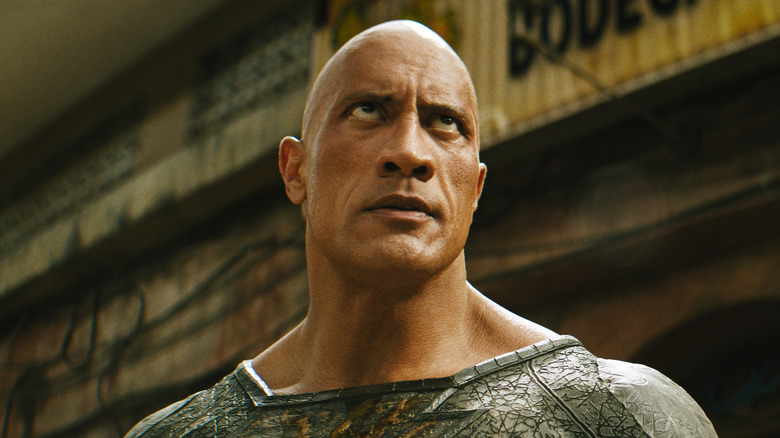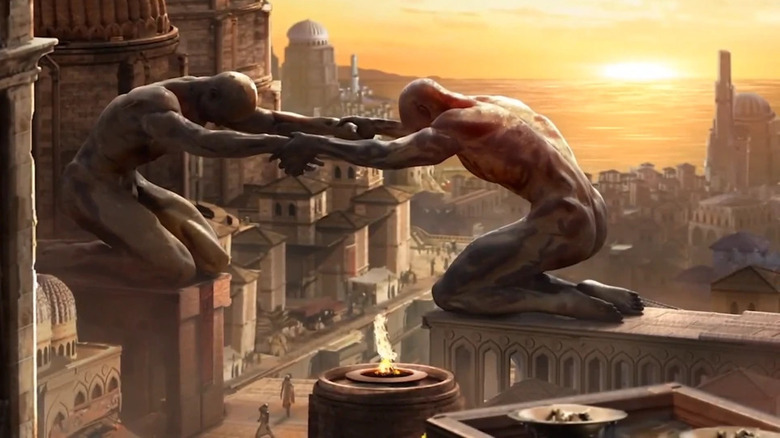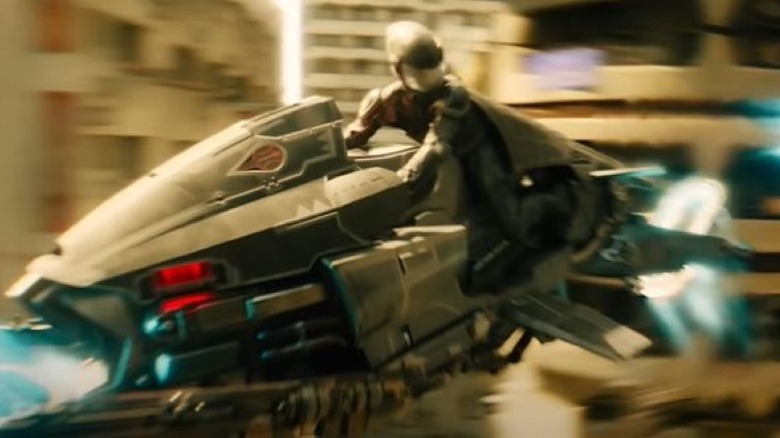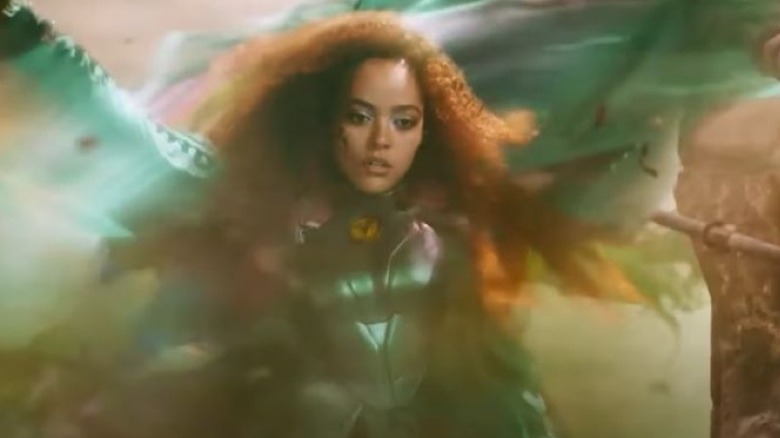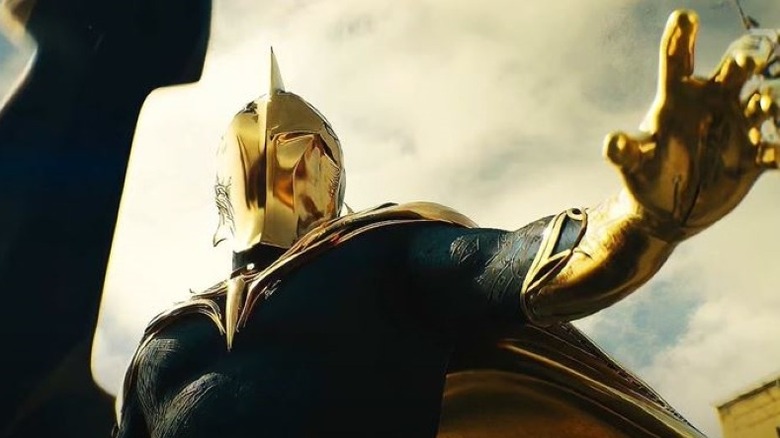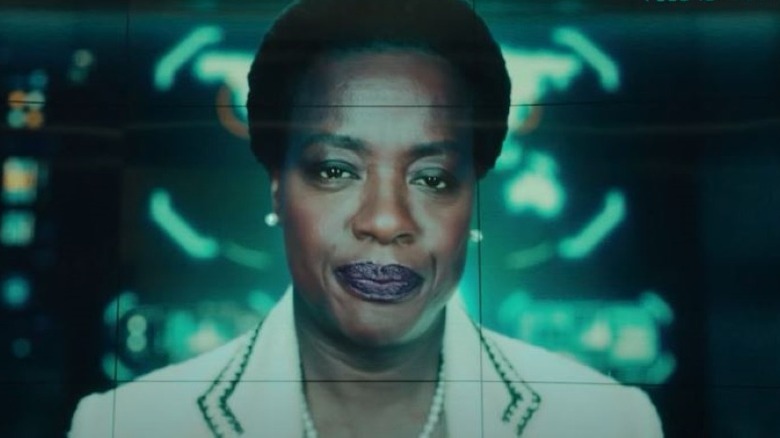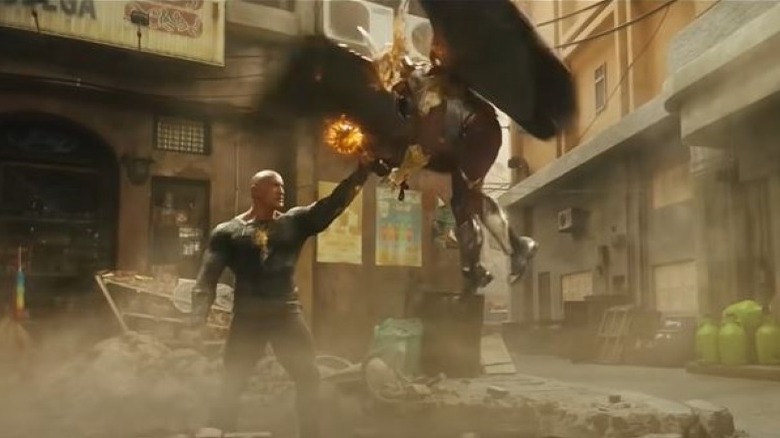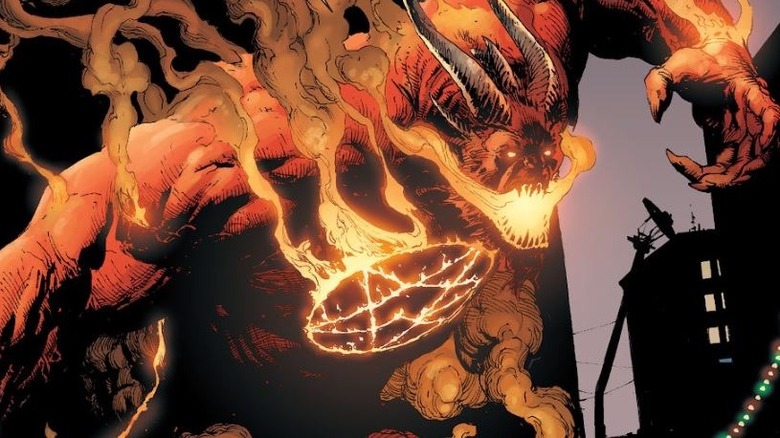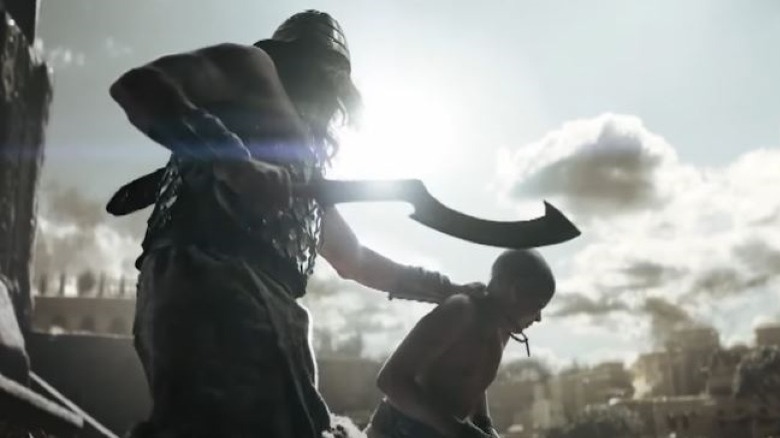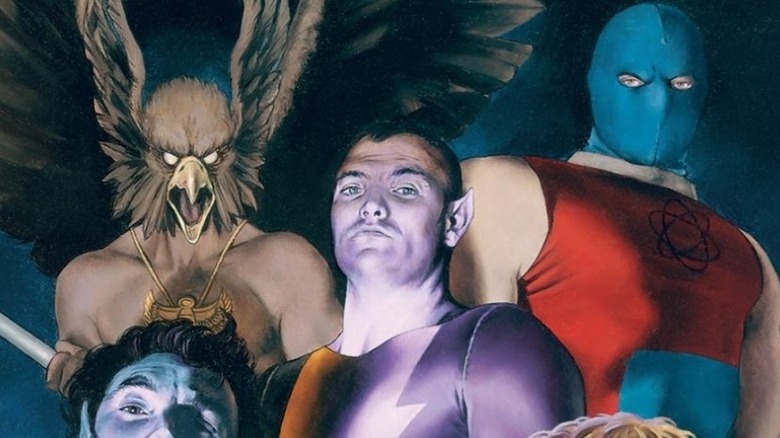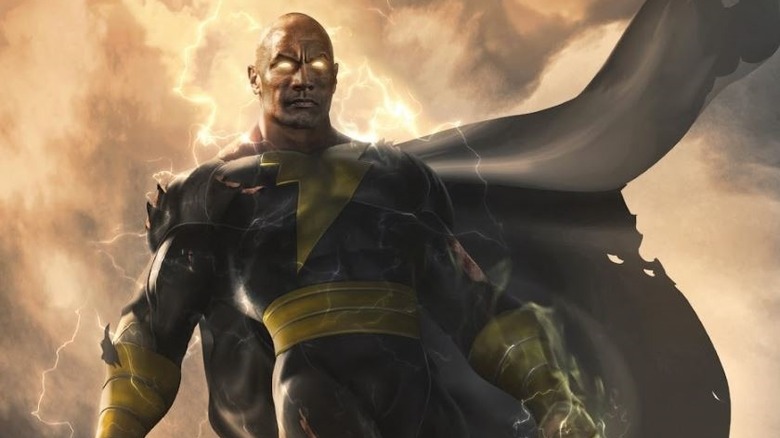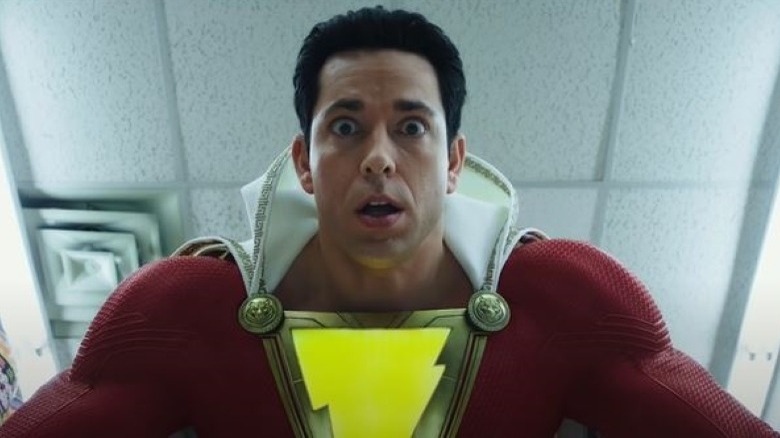The Biggest Differences Between The Comics Version Of Black Adam And The Live-Action Movie
Although Black Adam may be defined as an anti-hero, the new Dwayne Johnson-led film is a smash superhero experience. Audiences and critics may disagree about the movie's success, but "Black Adam" is set to become the entrance and road map to the new DC Universe. The introduction of The Rock's version of Teth-Adam softly resets the established DC film franchise while giving future spin-offs a formula and story to build upon.
Unsurprisingly, "Black Adam" follows the precedent set by the endless collection of comic book adaptations that have come before, by making necessary adjustments to the character's history to fit an alternative media's parameters. Truthfully, comic books have the jump on movies, as they are built upon decades of sometimes conflicting backstories and origins. It can only be expected that any adaptation is going to have to make cuts and cherry-pick the best plots out of its target character's ongoing chronicle. Below is an explanation regarding some of the most significant changes that "Black Adam" made in modifying a comic book villain that has been around since 1945 to fit him into a two-hour feature.
Advancing Kahndaq
Kahndaq is the fictional nation in Northeast Africa where Black Adam was born and, thousands of years later, became its protector. Taking much of its inspiration from Egypt, Kahndaq is described in "Black Adam" as the first self-governing community on Earth – much in the same way Egypt is considered a cradle of civilization and offers some of the earliest examples of urbanization and a centralized government. Subsequently, the film version of Kahndaq is represented similarly to how the nation appears in comic books. However, there are some subtle differences when it comes to how developed the country is in the modern era.
Aside from a few crumbling pieces of ancient architecture, the capital city of Shiruta appears to be a bustling modernized city, complete with skyscrapers and a thriving economy. However, in the comic books, centuries of war and destruction have kept Kahndaq from becoming a developed nation. More often, the North African country is depicted with antiquated structures rather than Western-style architecture. Additionally, by the time Black Adam returns to become the nation's new leader, Kahndaq was under the rule of a dangerous dictator, Asim Muhunnad, and not the victim of a would-be invasion by the technologically advanced Intergang.
True origins of Intergang
The primary villains during the events of "Black Adam" are the technologically advanced militant group Intergang. Although their origins, intentions, and purpose are not explored in depth, the movie reveals that Intergang is working with Ishmael in his attempts to find the Crown of Sabbac and inevitably become the sole ruler of Kahndaq. Still, by the movie's conclusion, Intergang's motives are not revealed, nor is it explained where the group received its powerful technology. Without exploring the villainous group's backstory, it feels like this militant group was injected for the simple purpose of giving its titular character something to punch.
Thankfully, the literary background of Intergang elaborates on what and who they are, and why they are in Kahndaq during the film's events. The comic version of Intergang is a crime syndicate that regularly operates in Metropolis and unsuspectingly receives its orders and weaponry from the ruler of Apokolips, Darkseid (the main antagonist of "Justice League"). Under the influence of its secret benefactor, Intergang puts most of its efforts into searching for the Anti-Life Equation, which is likely what they are doing in Kahndaq.
A reimagined Adrianna Tomaz
Debatably, there is no character in "Black Adam" that underwent more redesign than Adrianna Tomaz. In the film, she is at the head of a group of freedom fighters hoping to save her country from foreign invaders. It is thanks to Adrianna's knowledge and effort that Teth-Adam is awoken from his imprisonment. Along with her younger brother, Amon, she is integral to the ancient being's adjustment to the modern world, as well as his subsequent acceptance as Kahndaq's new champion. Additionally, Adrianna's inclusion in the DC movie insinuates that she will inevitably take on her comic book superhero identity Isis and become Black Adam's wife. However, this origin story of Adrianna Tomaz is barely recognizable from the source material.
Surprisingly, Isis is one of the few comic book characters that is an adaptation of a live-action superhero. Originally named Andrea Thomas, she first appeared in "The Secrets of Isis" television series as a high school science teacher who gained super abilities from an ancient Egyptian amulet. Also making an appearance in the 1974 live-action "Shazam!" series, Isis made her comic appearance shortly after, beginning in titles associated with the television shows. Meanwhile, Adrianna Tomaz first appeared in 2006 as a slave woman gifted to Black Adam as an offering. After freeing her, Adam became entranced by her strong will and vision of how he could be a benevolent leader. The two fell in love and Teth-Adam gifted her the powers of Isis, which she subsequently shared with her younger brother.
Differences around Atom Smasher and Cyclone
The newest recruits to the Justice Society's ranks in "Black Adam" are Atom Smasher and Cyclone, performed by Noah Centineo and Quintessa Swindell. The rookie superheroes remain generally faithful to their comic book counterparts, with minor tweaks and changes that help to serve the story. Thankfully their respective backgrounds help to add depth to personalities that are otherwise dead weight to the plot. "That's the beauty," said "Black Adam" producer Hiram Garcia about the new Justice Society members, "of all the characters we have in this film, is that no one is coming from a cookie-cutter pass. They all have complex stories to tell that do affect their performances in terms of how those characters function."
Fittingly, much of Atom Smasher and Cyclone's complicated backstories were omitted in the final cut of "Black Adam." Like Smasher, the comic book version of Cyclone also inherited her abilities from a veteran member of the Justice Society, Red Tornado — though she was forced into the nanobot experiment that the film briefly mentions. Meanwhile, the comic variant of Atom Smasher had a different relationship with the JSA founder, cameoed by Henry Winkler: He is his godson rather than his nephew, and he inherits his abilities from his supervillain grandfather Cyclotron. And, as hinted at in the movie, comic's Smasher chose to stay in the newly freed Kahndaq with Black Adam, the two eventually developing a brotherly relationship.
Dimming Doctor Fate's light
The most significant tragedy in "Black Adam," and a mistake that comic book enthusiasts will have a hard time forgiving, is the flagrant nerfing of Doctor Fate's powers and abilities. Preformed by Pierce Brosnan, the golden-helmed magician offers some of the movie's most visually stunning moments. However, he is not nearly as powerful in comparison to his comic equivalent.
Doctor Fate is undoubtedly one of the comic book industry's elite sorcerers, frequently considered more proficient in the mystic arts than his Marvel doppelganger, Doctor Strange. Unfortunately, the live-action Fate does not get the opportunity to showcase his impressive capabilities, and is ultimately defeated by the demonic villain Sabbac. Doctor Fate from the comic books would have figuratively ripped Sabbac in half, much in the same way Teth-Adam literally did during the film. Still, it should be noted that Doctor Fate has a history of dying in the comics, and the cinematic franchise has set itself up to explore the destiny of his famous helmet in future installments.
Amanda Waller's involvement
Audiences have become quite familiar with Amanda Waller from her placement in both "Suicide Squad" movies and the HBO Max spin-off "Peacemaker." However, her arrival in "Black Adam" is a bit of a headscratcher. Also known as "The Wall," she is a government figure who typically operates in the dark, employing the underhanded Suicide Squad tactics of sending criminals into amnesty work. The movie surprises when Waller contacts the Justice Society to do her dirty work in Kahndaq, rather than utilizing her own reformed supervillain team. Later, she is able to "call in a favor" by sending Superman to pay a visit to Black Adam's new temple.
Suddenly, the DC movie is treating the secret government administrator as an authority over all meta-human operations, making her behave more like Nick Fury from the Marvel Cinematic Universe. Truthfully, the Nick Fury-esque role is one that Amanda Waller filled in the comics when she served as the US Secretary of Metahuman Affairs under President Lex Luthor. Regardless, unless future DC films reveal that The Wall received a pretty significant promotion, the inclusion of her in "Black Adam" does not align with her portrayal thus far.
Black Adam and Hawkman's relationship
One of the more exciting additions to "Black Adam" is Aldis Hodge's performance as Hawkman. Representing the moral opposition to Teth-Adam, Carter Hall is not only a pillar of good but a strong combatant, both physically and through witty discourse. While Hawkman has plenty to do in the film, the character's origins are one of the least explored compared to his super peers. As an established hero, Hall is the main representative of the Justice Society, bringing his own jet and resources to the battle in Kahndaq. But otherwise, we are told surprisingly little about him as a character.
In the world of comic books, Hawkman is far more established than his on-screen counterparts, being a popular superhero since his arrival in 1940. A regular member of the Justice League, the comic version of Hawkman is often included in some of DC's biggest events. And while there have been multiple iterations of the character, his powers include reincarnation, meaning Carter Hall is equally as old as Black Adam. Where the movie differs is having the two powerhouses meeting for the first time where they should at the very least be aware of one another's reputation. In fact, if it were more faithful to the source material, Hawkman and Black Adam would have clashed thousands of years prior.
Streamlining Sabbac's story
At the center of the plot in "Black Adam" is Ishmael's deception as he obtains the Crown of Sabbac and becomes the demonic beast his ancestors intended. Including the hellish supervillain gives the film substance, offering the heroes someone to punch and blending Teth-Adam's past with the present. Unsurprisingly, Sabbac's history is quite different in comic books than how it is depicted on screen. Sabbac, like Adam, is traditionally the archnemesis of Captain Marvel and his family of superheroes.
In "Black Adam," Sabbac serves as the dark opposite of Shazam, gaining his power from demons instead of gods. However, Ishmael was not the first version of Sabbac, and was written as a New York crime boss who stole the powers from his successor. Black Adam has never fought the demonic villain in comics, although he did control Sabbac for a battle with the Marvel Family. Additionally, while the film does get most of his powers correct, Sabbac is more often depicted as a monster that stands several stories tall.
Tweaks to Black Adam's origin story
From tortured slave to the champion of Kahndaq, the origin story of how Black Adam gained his godly powers is quite similar between comic books and the live-action film. In both scenarios, Teth-Adam was a tortured soul who used his newfound powers in unethical ways, leading to him being banished by the wizard Shazam — although the comics sent him across the universe instead of burying him in the Earth. Still, the reveal that Adam was gifted his powers by the true hero of Kahndaq is where the anti-hero's origins diverge significantly from the source material.
The movie offers a heartfelt tale of Teth-Adam's son leading a resistance against his dictator, earning him the trust of the wizard and receiving godlike abilities, only to give up his gifts to his injured father. The comic books, on the other hand, have a much darker take on the origin story, with Teth-Adam's nephew being the one to earn superpowers. The nephew chooses to share his gift with Adam after the older man loses his family. Shockingly, Black Adam betrays his savior, murdering him for all his power. While he's still portrayed as a grieving father, the comic book version remains much more sinister.
How the story happened in comics
Adaptations such as "Black Adam" would not work without taking advantage of the decades of storytelling that precede them. Every popular superhero movie currently available can point to certain literary events as the source of their inspiration. Although many elements can be omitted, and pieces of the plot rearranged, the superhero movie genre relies heavily on established comic stories. And The Rock's new metahuman action film is no different, taking its main plot from comic books.
Pieces of the story, like the Crown of Sabbac, are borrowed from other comic tales, but the rise of Black Adam as the new champion of Kahndaq originates in the 2006 run called "Black Reign." The story arch spans the titles "JSA" and "Hawkman," and features rising tensions in the Middle East. Shortly after Black Adam has left his reformed position in the Justice Society, he leads his own team of heroes into Kahndaq to overthrow its militant dictator, Asim Muhunnad. Hawkman, Doctor Fate, and the rest of JSA fight Black Adam's squad as they attempt to take control of the country. Ultimately, Teth-Adam wins the war and becomes the self-proclaimed leader of Kahndaq, signing a treaty to keep Earth's metahumans out of the country's airspace.
Black Adam: Good or Evil?
The movie's titular character is equal amounts disgruntled and foreboding, although The Rock's natural charisma helps Black Adam shine in an industry already swarmed with high-flying superheroes. He colorfully portrays a gruff and resentful outlaw, gradually learning how to take the high road and reset his own moral karma. Subsequently, the movie turns the classic comic book supervillain into a complex rogue residing in the grey area between good and evil, despite this transition taking decades to manifest in the source material.
Calling Black Adam an anti-hero is a stretch, considering the character is an overpowered dictator who has murdered countless innocent people and is consistently involved in global threats. Dedicated to slaughtering his counterpart, Captain Marvel, the comic book Adam is as much a supervillain as they come — the only difference being his political position as the leader of a sovereign state. Only by coincidence does Teth-Adam team up with the good guys, but even that is unremarkable: Essentially every great comic book supervillain has switched sides at one point or another. Black Adam is a bad guy who follows his own set of codes and principles, making him better described as an anti-villain rather than semi-heroic.
Where is Captain Marvel?
Undoubtedly, the most confusing thing that the DC Extended Universe movies have done is alienate Captain Marvel from Black Adam. The two characters share powers, abilities, origins, and super suits. For all intents and purposes, the hero of "Shazam!" and Dwayne Johnson's new super alias are practically identical. Keeping the characters out of each other's films must make things awfully bewildering for the average movie-goer. Meanwhile, comic enthusiasts are more than aware of the two characters' long literary past. After decades of combat between the two, Black Adam essentially rode the coattails of Captain Marvel into the comic history books.
Coincidentally, the "Shazam!" movie and "Black Adam" both opt to include Superman in their post-credit scenes, instead of involving one another. Considering Dwayne Johnson has already passed up the opportunity once, Captain Marvel's upcoming sequel will likely also avoid a Teth-Adam cameo. Most likely, it's the "Black Adam" actor who has championed his character past the long-time archnemesis and is instead looking for a more A-List clash with the Man of Steel. But for many comic book fans, neither Captain Marvel nor Black Adam will feel quite right until they clash on the big screen.
